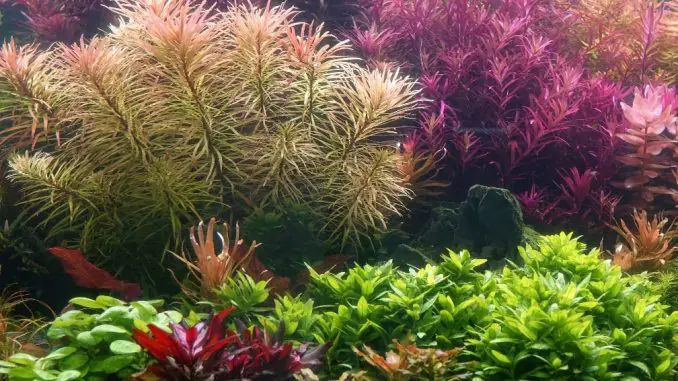
Rotala Wallichii, or Whorly Rotala, is one of the more colorful and attractive aquatic plants. If you’re looking to take your aquascaping up a notch, these iconic pink and purple flowering plants have a great combination of fluff and spike.
They’ll definitely add some pomp and circumstance to your aquarium vibe. These plants do require a bit of a green thumb, so they’re not for beginners in the hobby.
Rotala Wallichii gets its common name of Whorly because the leaves grow in whorls; that is, their leaves grow up from a single point, expanding in a circular pattern.
In this article, I’ll discuss the origins of Rotala Wallichii, and offer propagation advice, best parameters, substrate, and everything you need to keep these aquatic plants happy and healthy.
TABLE OF CONTENTS
Rotala Wallichii Facts & Overview
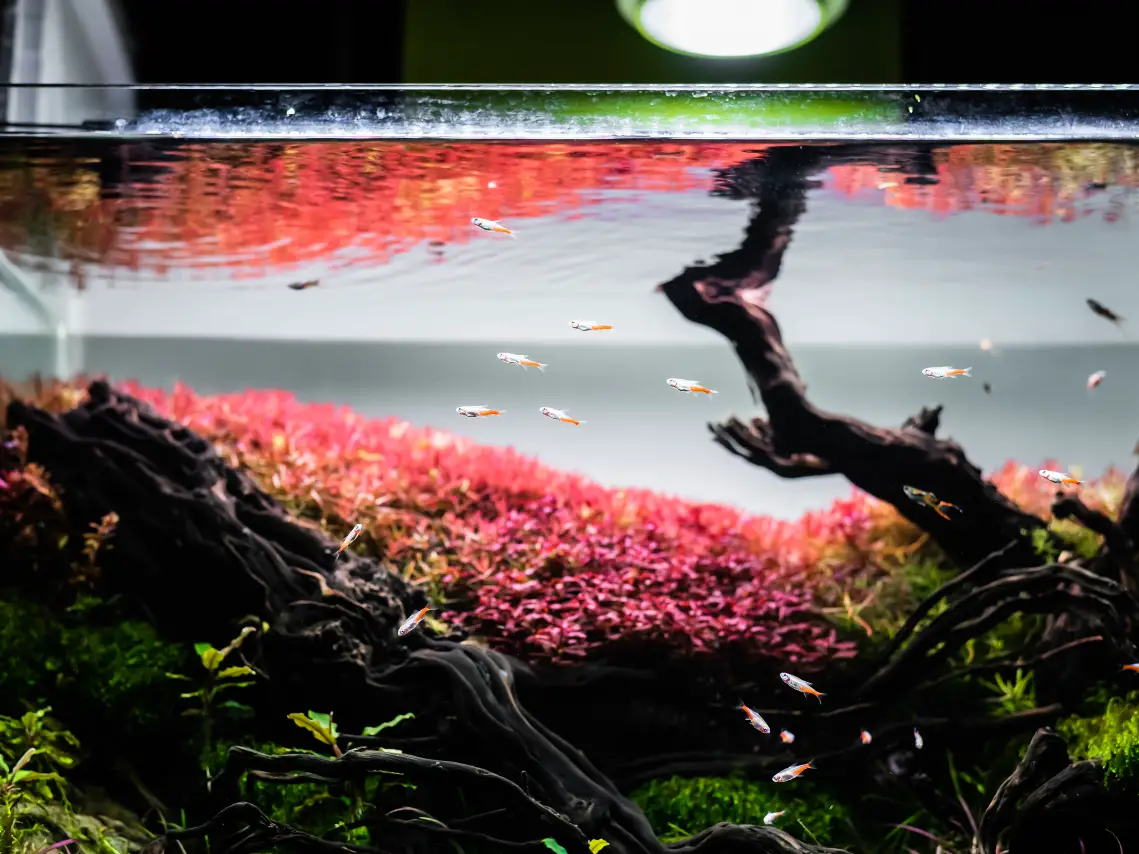
| Category | Rating |
| Care Level: | Moderate to difficult |
| Temperature: | 64.4°-82.4° F (18-28° C) |
| Color Form: | Green |
| Propagation: | Cuttings and side shoots |
| Size: | 10-15 inches |
| pH: | 6.5-5-7 |
| Family: | Lythraceae |
| Substrate: | Gravel |
| Placement: | Middle ground and background |
| Lighting: | Bright |
There are a few different types of Rotala plants used in the aquarium trade. In addition to Rotala wallichii, Rotala rotundifolia, Rotala nanjenshan, and Rotala indica are common in home aquariums. Rotala Wallichii, commonly known as Whorly Rotala, is the most difficult of the rotalas to care for in a home setup.
If you’re an experienced aquarist and up to the challenge, Whorly Rotala is worth the effort: it’s a spikey plant that creeps up the tank and forms lovely pink and purple flowers on the stems. The stems are worthy in their own right, as they change colors.
In the wild, Whorly Rotala is found throughout Asia, populating tropical waters in China, India, Laos, Taiwan, Thailand, and Vietnam.
A fragile plant, Whorly Rotala can nonetheless successfully grow both submerged (fully underwater) and emersed (planted underwater, but passing the waterline and growing out of the water. Certainly, in your home tank, it’s likely to be fully submerged.
This emerged, aquatic foliage can thrive standing out of or rising above the surface of the water. We can also find these plants in a submerged state in moist areas like shorelines and rice paddies in Southeast Asia.
Features
Because these plants are so delicate, they should be paired with fish that have a calmer nature. Many species of fish will either feast on Whorly Rotala plants or dig them up. These aquatic plants are already challenging to care for, so if you have an established tank and you want to add Whorly Rotala, be mindful of who else is in your aquarium.
Some fish to avoid pairing with Whorly Rotala include:
- Buenos Aires Tetras
- Goldfish
- Monos
- Oscars (and other large cichlids that dig)
- Scats
- Silver Dollars
One of the interesting features of this plant is that the growth you’ll see varies depending on the circumstances. Whorly Rotala starts with a stem out of which shoots and leaves grow upwards in a circular design. This pattern, called whorls, looks different if it is emersed than it does when it is submersed.
Pro-tip: The shoots are more plentiful near the water’s surface–a fact that will be helpful when it’s time to propagate.
When Rotala Wallichii is emersed or growing above the water, its leaves are rounder and thicker. However, when Rotala Wallichii is fully underwater, as it is in the majority of aquariums, its leaves are oval and narrow in appearance.
In the wild, an observer might very well see both leaf patterns, but in the home aquarium, expect to see the narrow, oval leaves. If you have an extremely large tank that allows for a water line with enough space for plants to grow above the water, you could see both leaf patterns.
The other time the hobbyist might be able to achieve growth with both patterns is when they are curating an outdoor pond.
Another feature that varies is the color, and that is based on the amount of light Whorly Rotala gets. Just like the shoots are more plentiful higher up, Whorly Rotala’s colors are most vibrant near the surface of the water.
The brighter the light, the more colorful hues you’ll see in your Rotala Wallichii plants. Their leaves can manifest red or brown to pink or purple. Some hobbyists report more pink and purple effects when the plant is in its emersed state.
Pro tip: Whorly Rotala does not grow in the wild in the United States, so if you have to dispose of it for any reason, let the leaves wither in the sun before composting. You don’t want to contribute to what could be considered weeds in your area. Alternatively, you can burn them but always employ safety measures before attempting a controlled burn.
You could also place them in plastic bags and then dispose of them in the trash. Avoid disposal that could potentially clog local waterways.
Appearance
Rotala Wallichii is classified as a red stem plant. The most striking feature of Whorly Rotala is its beautiful hues. As referenced in the previous section, the flowers they produce can range in color from red or brown to pink or purple.
Their stems, which are approximately 1 inch (2.5 cm) in diameter, range in color from orange to pink to red, sometimes even achieving a wine-like color.
The submersed leaves start out green and will change hues to orange and red with bright light, creating a more colorful accent.
A final word about color is related to the shoots, which will develop into a bright red when afforded optimal bright lighting conditions.
I’ve mentioned the signature whorl pattern, which forms a beautiful circle of growth up the stem, where we see beautiful side shoots, particularly near the water’s surface. These side shoots produce spike-like flowers and the whole plant has a fluffy, feathery appearance. These plants really create a decorative look in your home aquarium.
In terms of size, the average Rotala Wallichii plant reaches a height of 10-15 inches (35-40 centimeters). The leaves range from .6 to 1 inch (1.5-2.5 cm).
In the Features section, I mentioned the varying leaf appearance of this plant in its submersed and emersed state, so if you are looking for thicker, rounder leaves to identify this plant, remember that you might instead see the narrow, oval leaves if your Whorly Rotala is fully submerged.
Whorly Rotala has so many color and shape variations, and you have control over many of its appearance outcomes. This is one reason these plants are recommended for more experienced hobbyists.
If you’re looking for a more bushy appearance, I recommend planting 3-5 stems close together (leaving enough room for light to get through.) Use a pair of tweezers to plant the stems in the substrate so that you can control the placement and also prevent damage to the plants.
If you’re interested in plentiful side shoots, prune your Rotala Wallichii regularly. Consistent trimming results in increased side shoots. These can also be gently replanted into the substrate to create a lush appearance.
Habitat and Tank Conditions
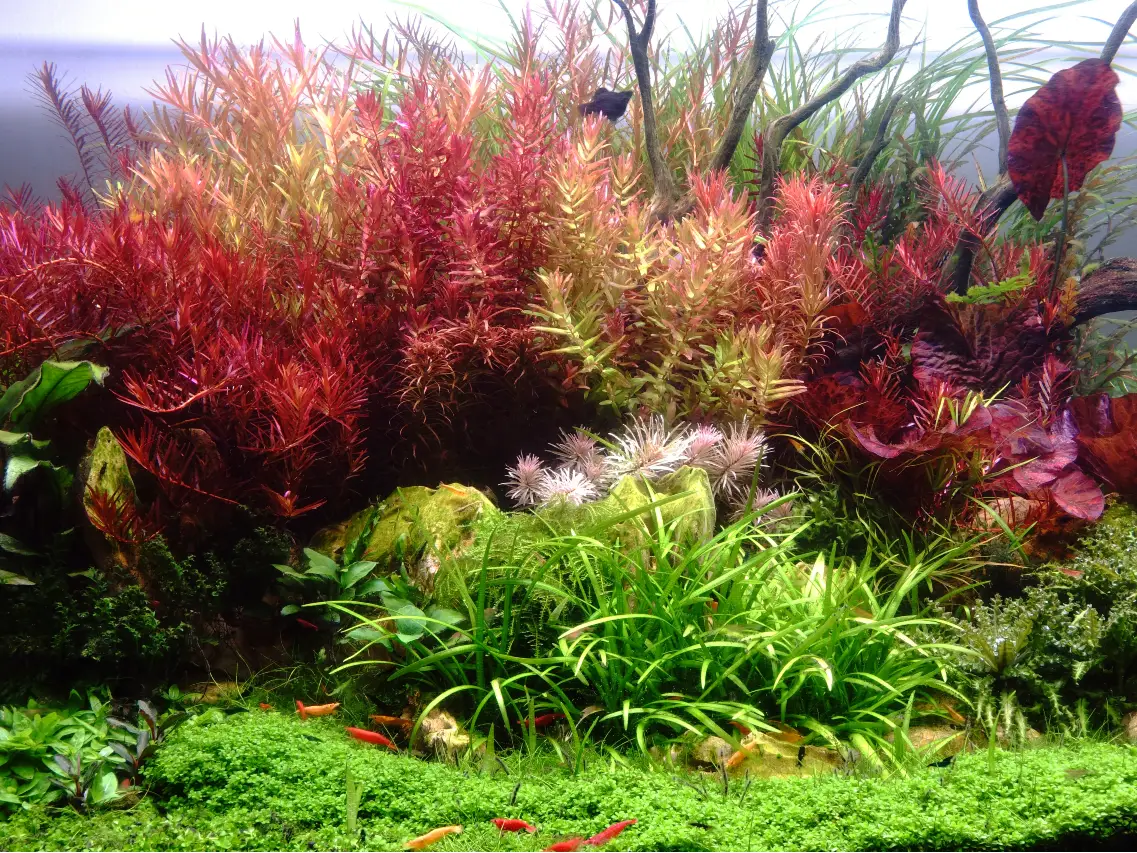
Rotala Wallichii will collect most of its nutrients from the water and the CO2 supplementation you provide. If you’re adding fertilizer, it’s best to use a water supplement.
Since these plants get their nutrients from the water rather than soil, you can choose a gravel substrate that is about 2 inches (5 cm) deep. This depth will give Whorly Rotala’s roots space to grow.
Secure the stems in the gravel substrate, but don’t bury them too deep.
The second major source of nutrition for Whorly Rotala plants is light. These plants need bright light–I recommend 2 watts per gallon of water. If their stems get sufficient light, you’ll be rewarded with shoot tips that have a bright red hue.
If you have a smaller tank, choose a background location for Whorly Rotala. If you have a larger tank, the midground can also be appropriate. Keep the bright colors of Rotala Wallichii in mind when curating your tank; they will offer a nice color contrast with your other plants.
Many hobbyists like the bushy effect achieved when bunching 3-5 Whorly Rotala stems together. Just make sure to have sufficient space between each stem so that they all have full access to the light they need.
Water Conditions
Rotala wallichii likes soft and slightly acidic water. While some aquatic plants are very forgiving about their water parameters, Whorly Rotala is pickier about their levels.
Make sure you have a decent filtration system that will help control algae and keep levels optimal for this delicate aquatic plant. Whorly Rotala needs a decent amount of CO2 infusion or injection to properly fertilize it.
It also benefits from iron, phosphate, and nitrates. Even though these plants prefer soft water, this same soft water can affect their leaves, which can become clogged and stuck, and also cloud the water. This can not only damage your Whorly Rotala but also cause detrimental conditions for your aquarium fish. Always check levels and monitor the physical appearance of your plants.
The optimal parameters to ensure the best quality of life for Rotala Wallichii:
- pH levels: 5-7
- Water temperature: 64.4° – 82.4° F (18-28 ° C)
- dKh: 12
- Nitrate: 1-15 mg
- Phosphate: 1-2 mg
Minimum Tank Size
Rotala Wallichii is flexible in the required tank size. They do well in smaller tanks, even successfully growing in nano tanks. Of course, you’ll have to stay on top of the pruning if you have a smaller tank. In smaller tanks, I recommend background placement.
Whorly Rotala also does well in larger tanks, where it can be planted in the middle ground of your aquarium. With a more sizable tank that has space for multiple plant species, you can also use it to contrast with other plants.
Planting and Growing
Rotala Wallichii is best suited for the midground or background of your home aquarium. Aesthetically, multiple stems are recommended in order to create denser groupings–up to 5 can be planted together. If you’re buying a bunch of Whorly Rotala, you’ll likely get 5 or 6 stems, enough for a group.
Even in groups, you’ll want to leave an inch or inch and a half (2-4 cm) between each plant to prevent algae formation. Algae can damage the delicate leaves of the Whorly Rotala. Additionally, this extra space will make sure that the bright light they need will reach the bottom of each stem.
Propagation can come from cuttings or side shoots. When you prune your Whorly Rotala, let the cuttings collect on the substrate below and more stalks will develop. If you cut off a top piece that is bigger, you can use a pair of tweezers to replant it into the substrate, where it will develop new roots.
Alternatively, you can cut off the side shoots that grow just under the water’s surface and replant those in the same way.
Care
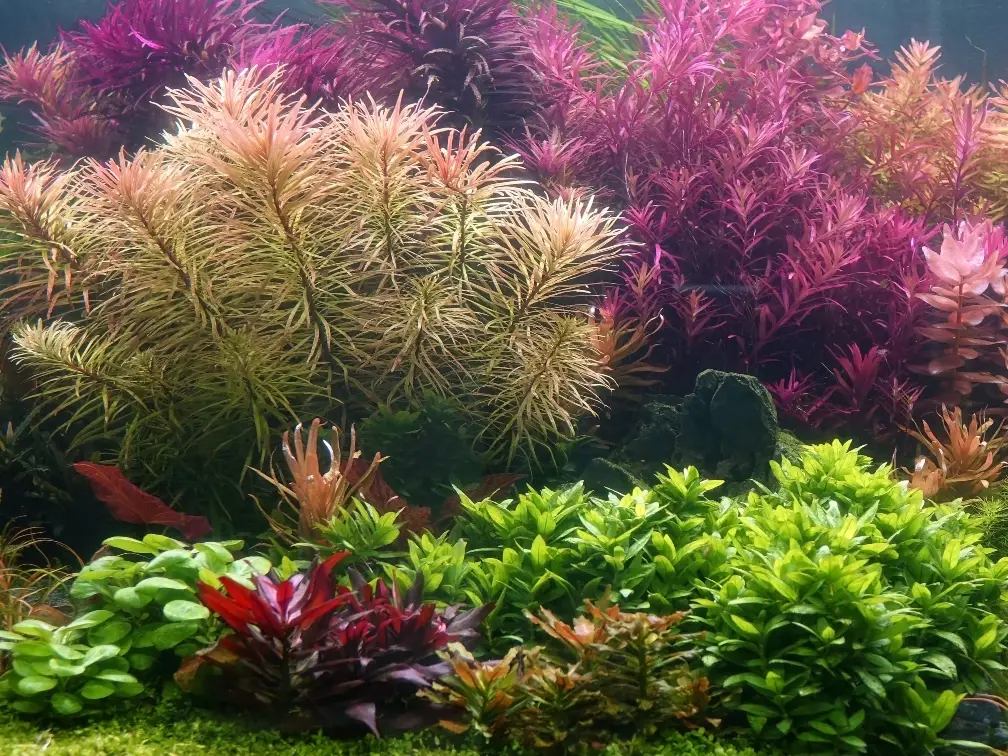
You should prune your Rotala Wallichii regularly so that it does not get too dense. When the upper part of the plant grows to about 2 inches (5 cm), you should trim it. The amount you’ll prune will depend on the size of your tank.
As I mentioned in the Habitat and Tank Conditions section, Whorly Rotala requires bright light, so you want to make sure to check for strong lighting. If the coloring of your Whorly Rotala is off, it’s likely due to inappropriate lighting conditions.
Because they are so delicate, it’s important to ensure they have sufficient nutrition, so checking the CO2 and nutrient levels often is vital.
Is Rotala Wallichii Suitable for your Aquarium?
Whorly Rotala is an attractive plant that adds something special to any home aquarium. However, due to their fragility and special care needs, this species is recommended for a more experienced aquarist. It doesn’t do well with all fish, and it requires heavy water testing and specific lighting.
What colors does your Whorly Rotala have? I’d love to hear some details in the comments below! Thanks for visiting the page.

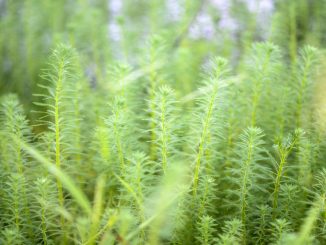
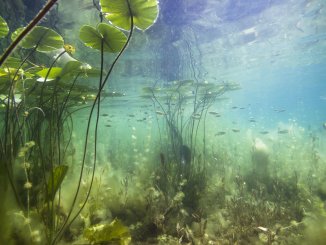
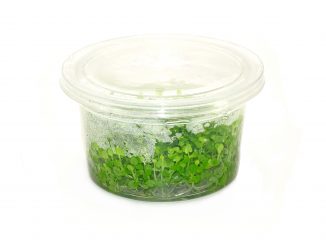
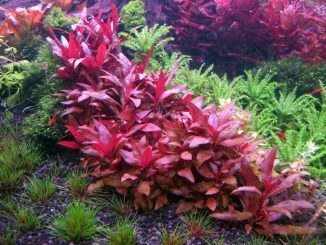
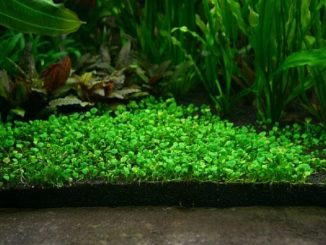
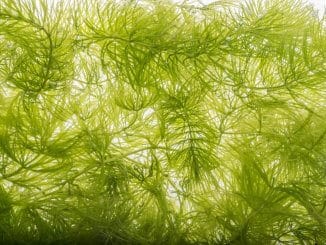
Be the first to comment